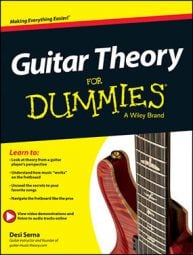So far, you’ve covered various chord progressions built out of root movements of 5ths and 4ths, but how is a lead guitarist supposed to play over these types of progressions? Secondary dominants borrow not only their chord function but also their notes from another scale. As a result, you treat them as V chords and use the dominant scale, Mixolydian mode, for your solos.
Here is a tab of a simple sequential bass line that works with the progression E-A-D-G.
![[Credit: Illustration courtesy of Desi Serna]](https://www.dummies.com/wp-content/uploads/418205.image0.jpg)
A root, 3rd, 5th, 6th, and f7th are played over each chord. These scale degrees belong to a Mixolydian mode; the f7th should give it away. As a lead guitarist, you can play complete Mixolydian scales over each chord, as many jazz and country players often do when dealing with dominant chords. However, if you consider yourself a blues or rock player, you may want to take a different approach.
Generally speaking, blues and rock guitar players like to keep things simple, both technically and musically. They don’t try to chase a series of dominant chords by changing scales for each one. Instead, they may choose to use one scale that works over the complete progression, often a minor pentatonic.
Take a look at “Hey Joe” by Jimi Hendrix, which uses an ascending 5ths progression C-G-D-A-E. The roots of these chords are all found in the E minor scale. In fact, the chords themselves belong to either E minor or E Dorian, the two most popular minor modes.
For this reason, the E minor pentatonic scale can work over the complete progression. It even works over the E major chord, creating a minor-over-major blues sound. Jimi Hendrix built the “Hey Joe” guitar solo out of mostly E minor pentatonic in the 12th position.

